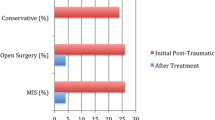Abstract
Indirect reduction and fixation is not a new method in the treatment of thoracolumbar burst fractures but the indications and efficacy are controversial. The current study was designed to evaluate the efficacy of indirect reduction without fusion. Sixty-four patients with single-level thoracolumbar burst fractures were identified and treated by this method. The outcome was analyzed by the Frankel method, radiographic measurements, and at the latest follow-up the Denis Pain Scale and Oswestry disability index (ODI) were used to assess back pain and functional outcome. The average follow-up period was 40.1 months. The anterior vertebral height (AVH) was corrected from 55.2 to 97.2% post-operatively and decreased to 88.9% after hardware removal. The posterior vertebral height (PVH) increased from 88.9 to 99.1% post-operatively and decreased slightly after implant removal to 93.7%. The average pre-operative canal compromise was 41.4%, which decreased to 13.7% at last follow-up. Except for three paraplegic patients, neurological status significantly improved or stayed normal in the study’s remaining 61 patients. Fifty-two of sixty-four patients had excellent or good function. At latest follow-up the average ODI score was 16.7 and the Denis pain score improved in all patients but one. Indirect reduction and fixation can not only restore vertebral column structure but also, more importantly, patients’ functional outcome.






Similar content being viewed by others
References
Aiki H, Ohwada O, Kobayashi H et al (2005) Adjacent segment stenosis after lumbar fusion requiring second operation. J Orthop Sci 10(5):490–495
Butt MF, Farooq M, Mir B et al (2007) Management of unstable thoracolumbar spinal injuries by posterior short segment spinal fixation. Int Orthop 31(2):259–264
Cheh G, Bridwell KH, Lenke LG et al (2007) Adjacent segment disease following lumbar/thoracolumbar fusion with pedicle screw instrumentation: a minimum 5-year follow-up. Spine 32(20):2253–2257
Dai L, Jiang L, Jiang S (2009) Posterior short-segment fixation with or without fusion for thoracolumbar burst fractures. A five to seven-year prospective randomized study. J Bone Joint Surg Am 91(5):1033–1041
Denis F (1984) Spinal instability as defined by the three-column spine concept in acute spinal trauma. Clin Orthop Relat Res 189:65–76
Esses S, Botsford D, Kostuik J (1990) Evaluation of surgical treatment for burst fractures. Spine 15(7):667–673
Farcy J, Weidenbaum M, Glassman S (1990) Sagittal index in management of thoracolumbar burst fractures. Spine 15(9):958–965
Maciejczak A, Barnas P, Dudziak P et al (2007) Posterior keyhole corpectomy with percutaneous pedicle screw stabilization in the surgical management of lumbar burst fractures. Neurosurgery 60(4 Suppl 2):232–241 (discussion pp 241–242)
Magerl F, Aebi M, Gertzbein SD et al (1994) A comprehensive classification of thoracic and lumbar injuries. Eur Spine J 3(4):184–201
Maynard FM Jr, Bracken M, Creasey G et al (1997) International standards for neurological and functional classification of spinal cord injury. American Spinal Injury Association. Spinal Cord 35(5):266–274
Muller U, Berlemann U, Sledge J et al (1999) Treatment of thoracolumbar burst fractures without neurologic deficit by indirect reduction and posterior instrumentation: Bisegmental Stabilization with Monosegmental Fusion. Eur Spine J 8(4):284–289
Roland M, Fairbank J (2000) The Roland–Morris disability questionnaire and the Oswestry disability questionnaire. Spine 25(24):3115–3124
Singn K, Kim D, Vaccaro AR (2006) Thoracic and lumbar spinal injuries. In: Herkowitz H, Garfin S, Eismont F, Bell G, Balderston R (eds) Rothman–Simeone the spine. Saunders Elsevier, Philadelphia, pp 1132–1156
Toyone T, Tanaka T, Kato D et al (2006) The treatment of acute thoracolumbar burst fractures with transpedicular intracorporeal hydroxyapatite grafting following indirect reduction and pedicle screw fixation: a prospective study. Spine 31(7):E208–E214
Verlaan J, Diekerhof C, Buskens E et al (2004) Surgical treatment of traumatic fractures of the thoracic and lumbar spine: a systematic review of the literature on techniques, complications, and outcome. Spine 29(7):803–814
Yang H, Shi J, Liu J et al (2009) Fluoroscopically-guided indirect posterior reduction and fixation of thoracolumbar burst fractures without fusion. Int Orthop 33(5):1329–1334
Yoganandan N, Maiman D, Pintar F et al (1993) Biomechanical effects of laminectomy on thoracic spine stability. Neurosurgery 32(4):604–610
Author information
Authors and Affiliations
Corresponding author
Rights and permissions
About this article
Cite this article
Yang, H., Shi, Jh., Ebraheim, M. et al. Outcome of thoracolumbar burst fractures treated with indirect reduction and fixation without fusion. Eur Spine J 20, 380–386 (2011). https://doi.org/10.1007/s00586-010-1542-3
Received:
Revised:
Accepted:
Published:
Issue Date:
DOI: https://doi.org/10.1007/s00586-010-1542-3



